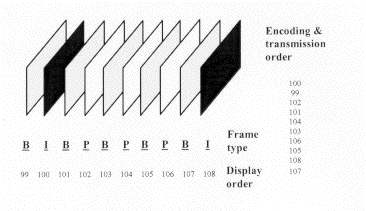
B-Frame Encoding
The MPEG encoder also has the option of using forward/backward interpolated prediction. These frames are commonly referred to as bi-directional interpolated prediction frames, or B frames for short. As an example of the usage of I, P, and B frames, consider a group of pictures that lasts for 6 frames, and is given as I,B,P,B,P,B,I,B,P,B,P,B,Š As in the previous I and P only example, I frames are coded spatially only and the P frames are forward predicted based on previous I and P frames. The B frames however, are coded based on a forward prediction from a previous I or P frame, as well as a backward prediction from a succeeding I or P frame. As such, the example sequence is processed by the encoder such that the first B frame is predicted from the first I frame and first P frame, the second B frame is predicted from the second and third P frames, and the third B frame is predicted from the third P frame and the first I frame of the next group of pictures. From this example, it can be seen that backward prediction requires that the future frames that are to be used for backward prediction be encoded and transmitted first, out of order. This process is summarized in Figure 7.16. There is no defined limit to the number of consecutive B frames that may be used in a group of pictures, and of course the optimal number is application dependent. Most broadcast quality applications however, have tended to use 2 consecutive B frames (I,B,B,P,B,B,P,Š) as the ideal trade-off between compression efficiency and video quality.

B-Frame Encoding
One disadvantage is that the frame reconstruction memory buffers within the encoder and
decoder must be doubled in size to accommodate the 2 anchor frames. This is almost never
an issue for the relatively expensive encoder, and in these days of inexpensive DRAM it
has become much less of an issue for the decoder as well. Another disadvantage is that
there will necessarily be a delay throughout the system as the frames are delivered out
of order as was shown in Figure ![]() . Most one-way systems can tolerate these
delays, as they are more objectionable in applications such as video conferencing
systems.
. Most one-way systems can tolerate these
delays, as they are more objectionable in applications such as video conferencing
systems.